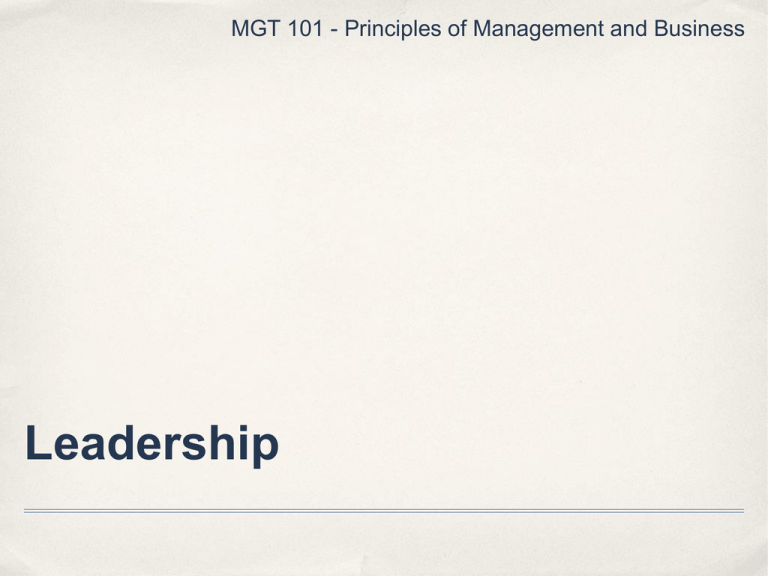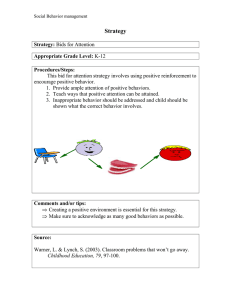Leadership MGT 101 - Principles of Management and Business
advertisement

MGT 101 - Principles of Management and Business Leadership Objective ✤ Define leader and leadership ✤ Compare different approaches to defining leadership ✤ View different types of leaders, based on behaviors and traits ✤ Discuss trust as the essence of leadership Leadership and Leaders ✤ Leadership: the process of leading a group and influencing that group to achieve its goals ✤ Leader: someone who can influence others and who has managerial authority Research Approaches of Defining Leadership Approach How? The Trait Approach Key traits that separate leaders from their peers The Behavior Approach To understand what managers and leaders do while on the job and to ascertain which of these behaviors reflect effective versus ineffective leadership The Situational Approach Ascertain what contextual intervening variables exist that influence leadership outcomes The Power-Influence Approach - Focuses on influence processes that flows from leader to subordinatesViews leadership as primarily a phenomenon of influence The Integrative Approach Usage of the above 4 approaches in any combination within a research study Source: Bird, Allan, Martha L. Maznevski, Mark E. Mendenhall, Gary R. Oddou, and Joyce S. Osland. "Leadership and the Birth of Global Leadership." Global Leadership: Research, Practice, and Development. London [u.a.: Routledge, 2008. 2-6. Print. Leadership Behaviors ✤ According to the University of Iowa leadership behaviors (or styles) are: 1. Autocratic Style: a leader who centralize authority, dictates work methods, makes unilateral decisions, and limits employee participation 2. Democratic Style: a leader who involves employees in decision making, delegates authority, encourages participation in deciding work methods, and uses feedback to coach employees 3. Laissez-Faire Style: a leader who generally gives employees complete freedom to make decisions and to complete their work however they see fit Different Leaders ✤ According to University of Michigan: ✤ Employee Oriented: a leader who emphasizes the people aspects ✤ Production Oriented: a leader who emphasizes the technical or task aspects ✤ Transactional Leaders: leaders who lead primarily by using social exchanges (or transactions) ✤ Transformational Leaders: leaders who stimulate and inspire (transform) followers to achieve extraordinary outcomes Different Leaders ✤ Charismatic Leaders: enthusiastic, self-confident leaders whose personalities and actions influence people to behave in certain ways ✤ Visionary Leadership: the ability to create articulate a realistic, credible, and attractive vision of the future that improves on the present situation Trust ✤ Trust: the belief on the integrity, character, and ability of a leader ✤ Dimensions of trust: 1. Integrity: honesty and truthfulness 2. Competence: technical and interpersonal knowledge and skills 3. Consistency: reliability, predictability, and good judgement in handling situations 4. Loyalty: willingness to protect a person, physically and emotionally 5. Openness: willingness to share ideas and information freely Learning Outcomes ✤ There are different approaches of defining leadership: trait, behavior, situational, and power-influence ✤ Thus, we describe leaders differently, in terms of charisma, transformation, autocracy... etc. ✤ Trust is the essence of leadership

